The first-gen Toyota 4Runner Turbo is rare, bulletproof, and in high demand
The first-generation Toyota 4Runner is amazing and beloved, but there was one major issue—it was laughably slow. The 0-60 time was pathetic, in the neighborhood of 15+ seconds. But Toyota had a cure: Turbo power! “At last, the legend goes Turbo,” crooned the mid-’80s advertisements for this stunning development. “Direct injection Turbo? What a charge!”
Produced for only two years from 1986 to 1987, the 4Runner Turbo was Toyota’s answer to complaints that the truck was basically a tortoise that drank gas. Those complaints were justified. The original carbureted 2.4L 22R inline-four only had 100 horsepower—not nearly enough power for the 3700-pound truck. In 1985 Toyota offered fuel injection as an option, bringing the total to 116 hp and 140 lb-ft of torque. Better, but still sluggish.
By adding a turbo to the legendary fuel-injected 22R-E, Toyota increased the 4Runner’s output to 135 hp and 173 lb-ft of torque, enough power to make it comfortable on highways. This was the only 4Runner ever sold in North America with forced induction from the factory. (Foreign markets received turbodiesel versions of the Hilux Surf but America was never that lucky.) On later generations, TRD superchargers were offered as a dealer option but were not shipped from the factory.

The turbocharged 22R-TE engine was the most powerful option until 1987, when Toyota introduced a 3.0-liter V-6 with 150 hp and 180 lb-ft of torque. Even though the V-6 is more powerful, it wasn’t as reliable as the four-cylinder; many of these V-6s developed head gasket issues. Its bulletproof reputation makes the 22R-TE highly desirable, but it is tough to find one with which the owner is willing to part. Production numbers are scarce for the first-generation 4Runner, so it’s difficult to know how many Turbos were produced, but they are indeed rare. To give you an idea, less than one-half of one percent of the first-generation 4Runners that Hagerty insures have the 22R-TE turbo engine. Because of this scarcity, Turbo 4Runners are insured at an average of 2.5 times the value of a standard 22R-powered 4Runner.
The first-gen 4Runner, produced from 1984 to 1989, has been a Toyota fan favorite since its release. Amidst the recent boom in the 4Runner’s popularity, prices have moved past the point of accessibility for many enthusiasts just looking for a cool truck to mess around with. Since last year, Hagerty’s volume of insurance quotes for first-generation 4Runners have increased 25 percent, with a 42 percent increase in the total number added to policies. A few recent sales over $20,000 for #3-condition (Good), original 4Runners have helped solidify it as a true modern collector car.
All that said, no 4Runner is more collectible than the Turbo, which considered by many Toyota die-hards the best of the breed. (Some may argue the fourth-gen V-8 is cooler. Tough call.) Really, which 4Runner you consider the best depends on your dream of how you’ll use it. If you’re looking to build a rock crawler, maybe the 1985 4Runner is your best bet, as it’s the last model year with a solid front axle and first that offered the fuel injected 22R-E. But, if you’re looking for more of a pure collector’s item for those in the know, the Turbo is the ticket.

The 22R engines are virtually indestructible, keeping most 4Runners on the road today with well over 200,000 miles on the original motor. This 1986 4Runner SR5 Turbo on Bring A Trailer is no exception. With 233,000 miles, its only just been broken in. Considering the mileage, the truck is in surprisingly good condition. There are some minor cosmetic issues—character enhancing dings and scratches—but the paint looks great for a 35-year-old truck. Since it spent most of its life in California and the last 20 years in storage, rust, which plagues most 4Runners of this era, is virtually non-existent. The side decals are faded but look original, although knowing 1980’s JDM Toyota’s you would expect large “Turbo!” decals. Instead, there is only a subtle turbo badge.
Even if other enthusiasts don’t know you’re driving something special, you won’t forget it while sitting in the “turbo” embroidered driver’s seat. A bright, digital instrument cluster is visible behind the “turbo SR5” labeled steering wheel—a feature that was only offered on Turbo 4Runners—that includes a real-time turbo boost gauge and a digital tachometer that’s looks like the inspiration for the Honda S2000’s tach. The most impressive part of this car is the condition of the interior. There are no cracks in the dash and the seats look almost new.

The 4Runner Turbo was only ever offered with a four-speed automatic, which will disappoint many enthusiasts. A five-speed manual was still offered on Turbo Toyota pickups, but the manual probably wouldn’t add much to the experience. Remember, this is from the early days of turbocharging, when turbo lag was much more of an issue. The automatic transmission doesn’t require the driver to lift off the gas while shifting through gears, which allows the engine to hold boost while accelerating. Plus, this automatic transmission was originally designed for the Supra and very over-engineered, just like the rest of the truck.
At the time of this writing, the bid is at $9000 with five days left and, I’d wager it will likely go much higher. Maybe that seem like a lot for a 4Runner with almost a quarter of a million miles, but if it is properly maintained, these vehicles could feasibly roll over the six-digit odometer. To sweeten the deal, this 4Runner even comes with a Toyota branded Swiss Army knife. We will be watching this one closely.
Photography courtesy Nathan Stratton/Bring a Trailer





These pics are in For Cronkhite
I have a 1986 Turbo 4 runner, digital dash, I love it to death!
is it 4 or 2 wheel drive